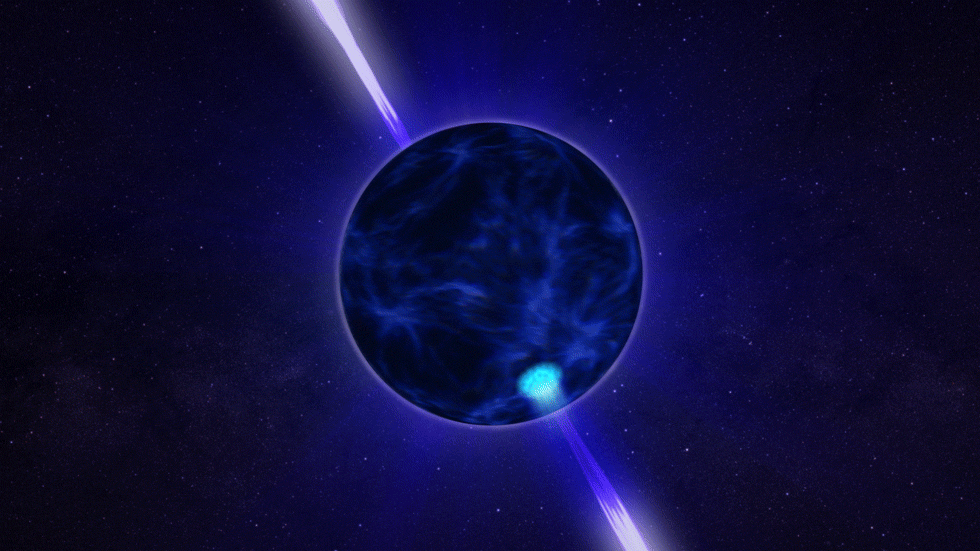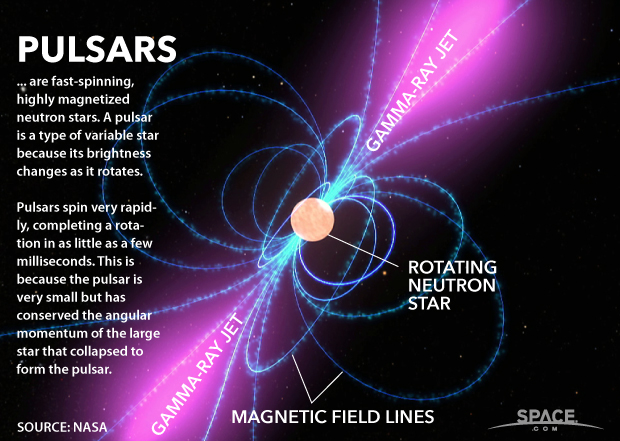Little Green Men? Pulsars Presented a Mystery 50 Years Ago
Fifty years ago this month, a small group of astronomers made a revolutionary cosmic discovery — explaining a phenomenon that they initially thought might come from an intelligent alien civilization.
In November 1967, Jocelyn Bell (now Dame Jocelyn Bell Burnell), a graduate student at Cambridge University in England, made what turned out to be the first detection of a pulsar — an incredibly dense ball of material formed when a massive star runs out of fuel and collapses in on itself. In the time since the discovery of pulsars, the objects have provided insight about the life cycle of stars and extreme states of matter, and provided evidence that supports Albert Einstein's theory of gravity. There are currently efforts underway to use pulsars to detect gravitational waves, or ripples in the fabric of the universe, and another to use pulsars as part of a space-based navigation system.
Pulsars spin rapidly, while simultaneously radiating opposing beams of radio waves out into space. The setup is similar to a lighthouse that spins around one up-and-down axis and radiates two beams of light from a second axis. To ships on the water, the steady beams looks like a light pulsing on and off. The same is true for pulsars; if one of the beams happens to sweep across the Earth, it appears to astronomers as though the object is blinking or pulsing. [What Are Pulsars?]
Bell Burnell was studying objects using a radio telescope she helped build at the Mullard Radio Astronomy Observatory, outside Cambridge, under the supervision of her advisor, Antony Hewish, who designed the instrument. The telescope was intended to help study the radio cosmos using a technique called interplanetary scintillation. Hewish intended to use this method on objects called quasars, or incredibly bright centers of massive galaxies, illuminated by material swirling around monster black holes. Quasars vary in brightness, and Hewish thought the interplanetary scintillation technique was appropriate for identifying those changes.
"We were looking far beyond [what could be seen with] optical telescopes," Hewish told the BBC of the radio astronomy he and his colleagues were doing then. "You felt very privileged actually. It was like opening a new window onto the universe, and you were the first people to have a look out through and see what was there."

Bell Burnell was in charge of operating the telescope and analyzing the data, according to an article she wrote for Cosmic Search Magazine in the 1970s. Using this technique, Bell Burnell spotted an object that appeared to be flickering every 1.3 seconds; this pattern repeated for days on end. The object didn't match the profile of a quasar. The signal conflicted with the generally chaotic nature of most cosmic phenomenon, the researchers would later explain. In addition, the light was of a very specific radio frequency, whereas most natural sources typically radiate across a wider range.
For those reasons, Bell Burnell, Hewish and some other members of the astronomy department had to acknowledge that they might have found an artificially created signal — something emitted by an intelligence species. Burnell even labeled the first pulsar LGM1, which stood for "little green men 1."
Get the Space.com Newsletter
Breaking space news, the latest updates on rocket launches, skywatching events and more!
A second discovery
Bell Burnell would later report that Hewitt called a meeting without her, in which he discussed with other members of the department how they should handle presenting their results to the world. While their fellow scientists might practice restraint and skepticism, it was likely that the possible detection of an intelligent alien civilization could create chaos among the public, the scientists said. The press would very likely blow the story out of proportion and descend on the Cambridge researchers. According to Hewitt, one person even suggested (perhaps only partly joking) that they burn their data and forget the whole thing.
Years later, Burnell wrote that she was rather annoyed at the appearance of the strange signal for another reason. As a graduate student, she was trying to get her thesis work done before her funding ran out, but work on the pulsar was taking away from her primary pursuit.
"Here I trying to get a Ph.D. out of a new technique, and some silly lot of little green men had to choose my aerial and my frequency to communicate with us," she wrote in the article for Cosmic Search Magazine.

But then, Bell Burnell resolved the problem. She went back through some of the data from the radio array and found what looked like a similar, regularly repeating signal, this one coming from an entirely different part of the galaxy. That second signal indicated that this was a family of objects, rather than a single civilization trying to make contact.
"It finally scotched the little green men hypothesis," Bell Burnell said in the a BBC documentary filmed in 2010. "Because it's highly unlikely there's two lots of little green men, on opposite sides of the universe, both deciding to signal to a rather inconspicuous planet, Earth, at the same time, using a daft technique and a rather commonplace frequency."
"It had to be some new kind of star, not seen before," she said. "And that then cleared the way for us publishing, going public."
In 1974, the Nobel Prize in Physics was awarded to Hewish, along with radio astronomer Martin Ryle, "for their pioneering research in radio astrophysics: Ryle for his observations and inventions, in particular of the aperture-synthesis technique, and Hewish for his decisive role in the discovery of pulsars." The omission of Bell Burnell's name as a contributor to the pulsar discovery has stirred controversy among scientists and members of the public, though Bell Burnell has not publicly contested the Nobel committee's decision.
Follow Calla Cofield @callacofield. Follow us @Spacedotcom, Facebook and Google+. Original article on Space.com.
Join our Space Forums to keep talking space on the latest missions, night sky and more! And if you have a news tip, correction or comment, let us know at: community@space.com.

Calla Cofield joined Space.com's crew in October 2014. She enjoys writing about black holes, exploding stars, ripples in space-time, science in comic books, and all the mysteries of the cosmos. Prior to joining Space.com Calla worked as a freelance writer, with her work appearing in APS News, Symmetry magazine, Scientific American, Nature News, Physics World, and others. From 2010 to 2014 she was a producer for The Physics Central Podcast. Previously, Calla worked at the American Museum of Natural History in New York City (hands down the best office building ever) and SLAC National Accelerator Laboratory in California. Calla studied physics at the University of Massachusetts, Amherst and is originally from Sandy, Utah. In 2018, Calla left Space.com to join NASA's Jet Propulsion Laboratory media team where she oversees astronomy, physics, exoplanets and the Cold Atom Lab mission. She has been underground at three of the largest particle accelerators in the world and would really like to know what the heck dark matter is. Contact Calla via: E-Mail – Twitter









